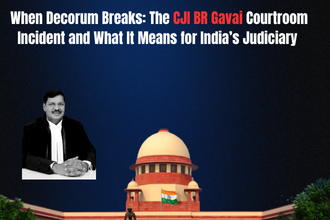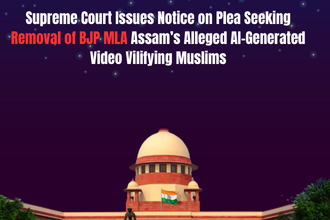Introduction
On October 6, 2025, an unexpected disturbance inside the Supreme Court of India made headlines across the country. During a routine morning session, a man dressed in a lawyer’s robe reportedly tried to throw an object at Chief Justice of India (BR Gavai). The incident was brief, but it has raised deep questions about the state of discipline, respect, and decorum within India’s courts.
What could have driven an individual—apparently a lawyer—to act out so dramatically inside the nation’s highest temple of justice? More importantly, what does this episode reveal about the relationship between the Bar and the Bench and the boundaries of free expression in a courtroom?
What Happened Inside the Supreme Court
Witnesses described the event as both shocking and surreal. During the mentioning round, a man in advocate’s attire began shouting slogans in Hindi:
“Sanatan Dharam ka apmaan nahi sahega Hindustan”
(“India will not tolerate disrespect towards Sanatan Dharma.”)
Before security personnel intervened, the man appeared to throw something—reports differ between a shoe and a rolled-up piece of paper—in the direction of CJI BR Gavai’s bench. He was immediately restrained and escorted out.
Despite the uproar, Chief Justice Gavai remained composed, instructing lawyers not to be distracted. His calm response—“Don’t get distracted. We are not distracted by this.”—set the tone for the remainder of the day and symbolized the judiciary’s commitment to restraint and dignity even under provocation.
The Immediate Backlash from the Legal Community
Within hours, the Supreme Court Advocates-on-Record Association (SCAORA) issued a strong condemnation. In its official statement, SCAORA described the incident as “unbecoming of a member of the Bar” and “a direct assault on the independence of the judiciary.”
The statement further emphasized that such acts undermine public confidence in the justice system:
“Any attempt to malign or act against a sitting judge of the Hon’ble Supreme Court constitutes a direct assault on the independence of the judiciary and undermines public faith in the justice delivery system.”
SCAORA also urged the Supreme Court to consider suo motu contempt of court proceedings against the individual. It reminded members of the legal fraternity that freedom of speech comes with professional responsibility, especially for those who are officers of the court.
Legal Perspective: Contempt of Court and Professional Misconduct
The Supreme Court is empowered under Article 129 of the Constitution of India to punish for contempt of itself. The Contempt of Courts Act, 1971 defines criminal contempt to include any act that scandalizes or tends to scandalize the authority of the court.
If the man involved is indeed a practicing advocate, the consequences could be serious:
- Contempt Proceedings: The Court may initiate action for criminal contempt, which can result in imprisonment or fine under Section 12 of the Act.
- Bar Council Disciplinary Action: Under Section 35 of the Advocates Act, 1961, an advocate found guilty of professional misconduct may face suspension or even disbarment.
- Criminal Charges: Separate penal provisions for disturbance of public order within a judicial institution may also apply.
Legal experts note that the Court has, in the past, adopted a zero-tolerance approach to any act that threatens judicial independence. In cases such as Re: Vinay Chandra Mishra (1995), the Supreme Court held that an advocate’s privilege of audience before the Court is conditional on their respect for judicial decorum.
Why This Incident Matters Beyond One Courtroom
While the act itself may seem like a one-off outburst, its symbolism runs deep. The Supreme Court of India is not merely another forum—it embodies the constitutional promise of justice and the rule of law. Any attack, verbal or physical, against a sitting Chief Justice represents a symbolic challenge to judicial authority.
In recent years, courts have been under growing scrutiny from different quarters—political, religious, and ideological. The line between dissent and disruption has become increasingly blurred. What happened in CJI Gavai’s courtroom underscores the need to reaffirm boundaries: disagreement with judicial reasoning must remain within ethical and constitutional frameworks, not spill into hostility or spectacle.
Freedom of Expression vs. Judicial Decorum
The incident also reignites an age-old debate—where does freedom of expression end and contempt begin?
The right to free speech under Article 19(1)(a) of the Constitution is not absolute. It is subject to reasonable restrictions, including those meant to preserve the authority and independence of the judiciary. The courtroom, unlike a public square or social-media platform, is governed by a distinct code of conduct rooted in decorum and order.
Advocates are not just private citizens; they are officers of the court. Their speech carries both privilege and responsibility. When one of them allegedly resorts to aggression or spectacle, it doesn’t just offend a judge—it shakes the professional trust that sustains the Bar-Bench relationship.
CJI BR Gavai’s Composure: A Lesson in Judicial Grace
Observers have widely praised CJI Gavai’s calm demeanour during the disruption. His refusal to react emotionally—choosing instead to resume business as usual—sent a clear message: the authority of the Supreme Court rests not in force, but in composure and continuity.
Such restraint mirrors earlier instances when Indian judges have faced personal or ideological attacks but upheld judicial dignity through silence and focus. In a time of heightened polarization, this moment served as a reminder of the judiciary’s resilience and its unwavering faith in the rule of law.
Restoring Public Trust and Professional Ethics
The larger takeaway from this episode is not merely about punishment—it’s about introspection within the legal community.
- How can professional ethics be strengthened?
- Should the Bar Council of India update disciplinary mechanisms for acts of public misconduct?
- What role can law schools and professional bodies play in cultivating respect for judicial institutions?
Reaffirming these questions is crucial because the legitimacy of the judiciary depends on public faith, and that faith is partly upheld by how the Bar conducts itself.
Conclusion: Protecting the Sanctity of the Supreme Court
The attempted attack on CJI BR Gavai is a wake-up call for everyone connected to the Indian legal system. It is not merely an act of individual defiance but a symptom of a growing disregard for institutional boundaries.
The Supreme Court Advocates-on-Record Association’s strong response shows that the Bar recognizes the gravity of the incident. Now, it is up to the broader legal ecosystem—courts, bar councils, and law schools—to ensure that such conduct is neither normalized nor repeated.
Judicial independence thrives not just through laws but through mutual respect between those who argue and those who adjudicate. The sanctity of the courtroom must remain inviolable—a space where ideas clash, not objects.



